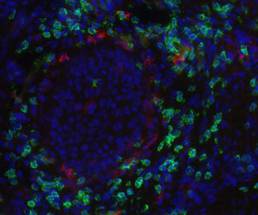Researchers Identify Cause of Aggressive SCCs in Recessive Dystrophic Epidermolysis Bullosa

Immune system-related enzymes contribute significantly to the development of aggressive and fatal squamous cell carcinomas early in the life of individuals with recessive dystrophic epidermolysis bullosa (RDEB), an international team of scientists led by researchers at the Sidney Kimmel Cancer Center–Jefferson Health finds. The discovery identifies new therapeutic strategies and reveals how chronic inflammation can spur cancer.
“We’re describing for the first time a mechanism that instigates tissue damage-driven cancers,” said senior author Andrew South, PhD, an associate Professor in the department of Dermatology and Cutaneous Biology at Jefferson.
Dr. South and colleagues wanted to figure out why squamous cell carcinoma (SCC) is so frequent in RDEB patients and what makes it so aggressive. He reached out to labs and clinics around the world that treat these patients to collect as many RDEB squamous cell carcinoma samples as possible, including Jefferson’s clinic for Adult EB patients, one of the few that offers treatment for cancer in this population. Then he and his team scrutinized the tumors’ genetic makeup.
When the researchers examined the genetic sequences of RDEB patients’ tumors, they found a group of enzymes called apolipoprotein B editing complex (APOBEC) caused a large proportion of the cancer’s mutations. These proteins help our immune systems by editing nucleic acid messages in pathogens, and in us. When APOBEC enzymes edit our DNA’s messages for example, they increase the diversity of antibodies available to fight off infection. In RDEB patients, inflammation from continued tissue damage and the persistent threat of microbial infection ratchets up APOBEC expression, leading the enzymes to attack the patient’s DNA, which then creates cancer-causing mutations.
In fact, DNA changes from APOBEC account for 42 percent of mutations in an RDEB skin tumors. In most people with skin cancer, APOBEC is much less active, making up about only about two percent of the mutations in tumors. The finding means these APOBEC alterations distinguish RDEB skin cancer from the kind caused by sunlight. And since RDEB skin tumors develop in places with chronic wounds, the discovery further provides a mechanism for how inflammation and tissue damage spur cancer progression.
Dr. South and colleagues then looked at which genes turn off or on and by how much in RDEB skin tumors compared to squamous cell carcinomas in other tissues. When the researchers grouped genes that perform similar biological functions together, they discovered RDEB skin cancers share more in common with those that develop in the oral cavity than cancer that develops in the skin from UV exposure. The finding reveals RDEB skin cancer acts more like squamous cell carcinoma of the oral cavity than the skin. Together with previous research that shows that like RDEB skin cancer, squamous cell carcinoma in the oral cavity is more aggressive than in the skin and also has more APOBEC mutations, Dr. South’s discovery suggests therapeutic approaches for oral cancer might be effective against RDEB skin cancers.
The research appears in the August 22 edition of the journal Science Translational Medicine.
As a result of the new work, the Department of Defense recently awarded Dr. South with a grant for nearly $1.75 million USD to figure out what turns APOBEC enzymes on and to look for compounds that disable them.
The Sohana Research Fund (now named Cure EB) and EB Research Partnership funded the bulk of the research described in this paper. Other contributors include Debra International and the National Cancer Institute (NCI 5R01CA194617).
PHOTO CAPTION/CREDITS:
New research shows that skin cancer cells in patients with butterfly syndrome have a pattern of genetic mutations that resembles a different kind of cancer, suggesting a potentially more effective avenue for treatment. Central blue cancer cells in butterfly syndrome are surrounded by immune cells labelled green or red. Inflammation drives cancer-causing mutation in patients with butterfly syndrome, which could help scientists better treat this cancer and better understand more common cancers such as those that occur in the mouth.
Credit: Laboratory of Andrew South, Jefferson (Philadelphia University + Thomas Jefferson University)

Facebook Comments